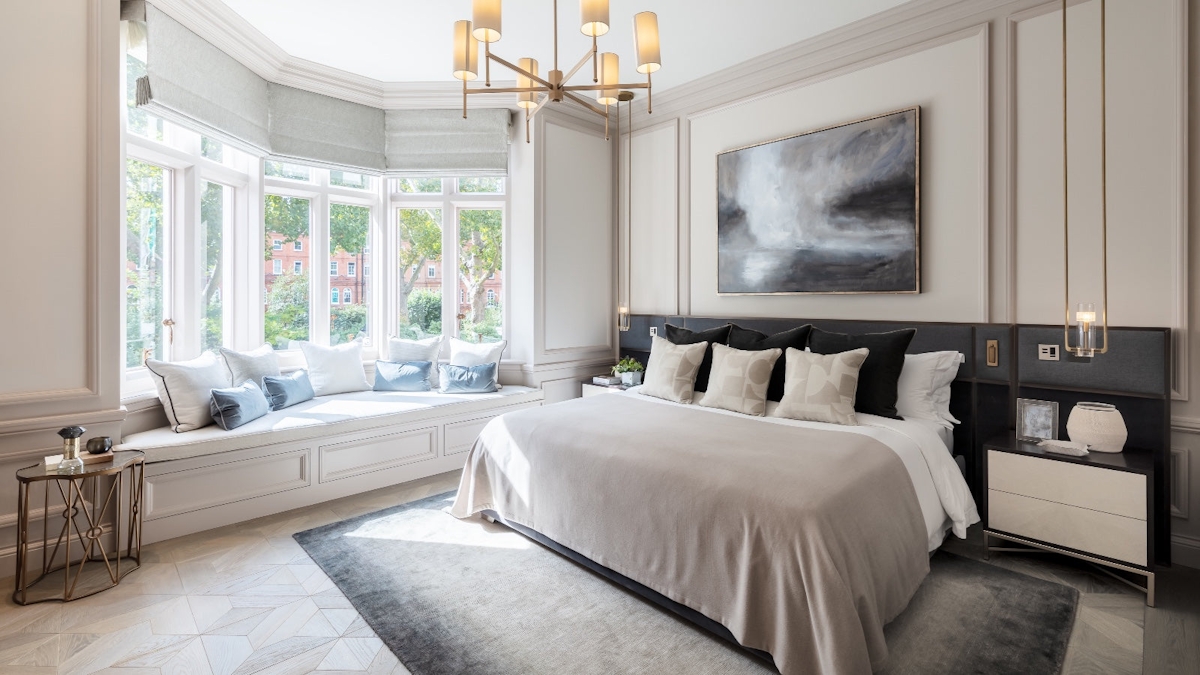Of all of the various decorating trends and style stalwarts, Chinese interior design is one of most unassuming of all. Though it’s talked about less frequently than Mid-Century, Scandi or Baroque, its constant momentum, its never-fading appearance and its perfectly poised pedigree has gained oriental design a reputation for being one of the most powerful and memorable design dynasties in existence.

Chinese Interior Design Trends
Celebrate Chinese New Year with this beautiful interior design style

What is Chinese interior design?
Whilst it’s almost impossible to pinpoint the precise style of a nation with as rich and as long a history as China, there are a number of visions that instinctively come to mind when closing your eyes and picturing a typically Chinese interior.
Sleek surfaces of dark, lacquered woods, dimly lit, decorative lanterns, meticulously hewn latticework furniture and screens, and colour palettes that blend often warm neutrals with punchy, saturated tones of red (considered the most lucky colour in Chinese culture), blacks and golds.
All true of a classic depiction of an oriental interior – a design direction drawn from thousands of years of Chinese culture and decorating evolution, traced back as far as 1000 BC.
Asian design is intrinsically linked to a zen-like atmosphere, and Chinese-style interior design will often build this sense of harmony by blending complementary influences from across the continent.
For instance, Japanese and Chinese interior design elements commonly merge; the delicate nature of traditional Japanese design offsetting the archetypal boldness of the Chinese aesthetic narrative.
The principal factor is that Chinese interior spaces are filled with a sense of harmony, fine decoration and craft, and management of colour and space.
What are the characteristics of Chinese interior design?
Rice paper lanterns or a cherry red and gloss black palette, whichever reference your mind conjures first is just one of the plentiful characteristics of Chinese interior design.
Bamboo elements
A wood not only known for being a food staple to China’s national treasure, the giant panda, but for being a Chinese symbol of virtue. It’s upheld as a symbol of traditional Chinese values and the potential harmony between mankind and nature.
In Ancient China, the plum, orchid, bamboo and chrysanthemum were known as ‘the four gentlemen’ and pine, bamboo and plum as ‘three gentlemen in winter.’ Even today, every part of the plant has spiritual meaning attached to it – the deep root, for example, denotes resoluteness and the tall, straight stem equals honour.
These deep meanings are what make bamboo so respected and wanted in inspired Chinese interiors whether it’s as a photo frame, as a mirror surround or even as a lampstand. And Chinese architects are beginning to turn to bamboo more and more as a sustainable building material.
The lacquer craft
Lacquer techniques are synonymous with Chinese interiors and were made ever more popular during the Ming Dynasty. It’s a skill that’s over 1400 years old and takes a huge amount of time and discipline.
On elaborately decorated luxury furniture, the makers would build up layers of different lacquers to carve into and create impeccably artistic scenes. One of the most famous examples were the Chinese Coromandel screens that used a vast combination of lacquering techniques.
The most basic is called kuan cai (meaning incised colours), but one piece of furniture can use up to 30 different techniques, each with up to 100 stages. More recently, lacquering has been applied to wall finishes too.
Separating screens
Whether used for decorative or room-dividing purposes – or both – screens are commonplace in Asian interior design. Shoji – a door, window or screen used in Japanese architecture made from translucent washi paper and a lattice of bamboo – are the most mimicked.
Chinese interior design uses similar screens as well as folding screens adorned with incredibly detailed murals, often mythological or historical in theme. One of the most famous examples were the Chinese Coromandel screens that used a vast combination of lacquering techniques.
The folding screen originated in ancient China and was later interpreted by other nations such as France and Sweden.
Latticework
Because of the respect for detail, precision and decoration, latticework is often seen in Chinese interior design. Lattices can be seen on anything from cabinet doors to shutters.
In screens, they also add an element of privacy and seclusion. Traditional canopy beds can have lattice or fretwork on the interior and exterior of the wood panelling too with the patterns they trace being geometric and more contemporary or floral-based.
Chinoiserie wallpaper
Exotic and magical, Chinoiserie wallpapers were (and still are) often painted by hand using lustrous hues and fastidious detailing.
Although not traditional to Chinese design — instead a European creation to represent the beauty of Chinese art and scenery — they flourished in the 18th century and became more widespread in the 19th – there are original examples in the Royal Pavilion in Brighton and in the Yellow Drawing Room at Buckingham Palace.
Deemed one of the most covetable wall coverings available, Chinoiserie wallpaper (real or imitation) can be used in panels, to line the inside of a closet or as a backdrop to display fine china or crystal and are known for fading slowly and elegantly.
Ming Dynasty tables
Ruling China from 1386 to 1644 A.D., the Ming Dynasty is renowned for many things, such as the population doubling, trade expansion, drama, literature and for creating world-renowned porcelain. Amongst these, furniture characterised by the period became one of the most revered examples of Chinese interior design, particularly the Ming Dynasty tables.
Made from precious wood and showing superb displays of craftsmanship and joinery, these tables would often be simple in terms of structure with minimal decoration. This would allow for the natural beauty of the wood to shine and for what decoration there was to be appreciated fully.
It’s often referred to as the golden era in the development of Ancient Chinese furniture so to unearth a Ming Dynasty antique table is one of the richest ways to celebrate Chinese interior design in your home.
Ornate wedding cabinets
Another icon in the history of Chinese furniture is the wedding cabinet. A traditional gift given to the family of the groom by the bride’s family, it was the centrepiece of her dowry. As such, they were generally elaborate in their carvings and etchings, and often had a large central brass plate and locking bar. Today, they’re collector’s pieces and work well as storage closets and even drinks cabinets.
Cloisonné detail
Like most considerations in Chinese-style interiors, history informs the path. Cloisonné is another ancient technique used for decorating pieces made from metal.
Metal wires are soldered to the form, such as a vase or piece of jewellery, in decorative patterns and then filled in with enamel, coloured glass or gem inlays resulting in a mosaic-like quality to the finished piece, although much more fine.
The delicate nature of cloisonné appealed to Chinese taste and by the 14th century was being used in China to decorate items such as vases and bowls. Today, you can expect to see at least one cloisonné piece in a Chinese interior, be it an ornament or a trinket box.
The tradition of the garden stool
Stools are a staple in oriental room sets and one of the most iconic designs is the barrel-shaped Chinese garden stool. Originally, it was used in China purely in outdoor spaces.
Many Chinese homes place emphasis on the landscape and the courtyard or garden, but where this isn’t possible, elements of the outdoors were gradually brought inside. Or, even if the garden were visible, the garden stool moving into the home was a way to build a bridge between the indoors and outside world.
By the Song Dynasty, these stools were habitually being used inside and out, for seating and as a side table. Now, they’re available in carved wooden designs, as the traditional garden stool was made, and glazed stone or porcelain which were deemed more suitable for our interiors. Lattice work is not uncommon on stool designs either.
Chinese interior design trends
The Marie Kondo effect, though Japanese in origin, is associated with pan-Asian design. Therefore, order and only having items in your home with purpose, which is in fact a Chinese custom, has led to a peak in the decluttering trend.
A Chinese-style interior rarely accumulates unnecessary objects, which are believed to drain the room and those within it of energy.
Other Chinese interior design ideas include a commitment to natural materials – a trend that’s far-reaching and a huge part of the global interior design commentary.
The Chinese perspective is about preserving nature, honouring nature and appreciating the positive effect using natural resources can have on a person’s wellbeing. By bringing nature into our homes, it helps us to let go of the from the bustle of everyday life, whether this is wooden furniture, rugs woven from natural fibres or using stones as objects of beauty and spiritual grounding.
Another trend that’s arisen from Chinese interior design is the use of screens to divide a room. Because over the last decade or two, there has been a seismic shift towards open-plan living, we’ve gradually begun to drift back towards the appeal of broken-plan.
Separated rooms mean we divide the space between cosy pockets and zones of activity. The Chinese tradition of using decorative screens in the room to section your space is something that’s being applied to large space in our homes as an interpretation of modern Chinese interior design.
How to incorporate Chinese Interior design in your home
Chinese interior decorating, like with any design influence, can be achieved in a maximalist or minimalist way. But there are perhaps three key stepping stones that will steer your scheme in a (far) easterly direction. The decision then is how much pressure to apply to the pedal and how much to turn up the volume.
Ultimately, how overt or subtle do you wish oriental interior design to dominate your room? And remember, even if you use all three of the following in combination, your scheme can still err on the quieter side of Chinese design.
Order and flow
Establishing immediately evident calmness in your room, a clear path to navigate yourself around the room with space, and everything having a palpable sense of belonging all attribute to the zen ideology.
The philosophy of Feng Shui is often the first connection people make with Chinese interior design – where energy forces are channelled to create a feeling of harmony in a space. It’s commonly referred to as the art of placement where the positioning and organising of items in a room optimise the ‘chi’ (energy).
Balance and order are deeply rooted in Chinese culture, so allow these aspects to be one of your room’s defining notions.
Colouration
Richness in colour is another tenant of traditional Chinese interior design. When an abundance of ruby red walls, ebony or mahogany fine furniture, and gold relief work, gilt decorative accents and brass metallics unite, the most rousing symphony of oriental design will be played from your space.
And if something so strong doesn’t suit your taste, choose at least one of the signature Chinese colours and use it in several places so it receives attention, such as a chorus of dining chairs, a decorative screen, or the colours used on your walls.
Think decoratively
Chinese design isn’t so much a rejection of bold lines and sharp form (indeed a lot of Chinese furniture adheres to these shapes). But, it does embrace and champion decorative form in a very big way.
To truly develop a Chinese-inspired scheme, you’ll need to make room for ornate carvings on furniture or lamps, you’ll seek out intricate patterns on fabrics, and you’ll welcome the more-is-more mindset in terms of attention to detail on key pieces in the room (all the while keeping everything else very much about less-is-more).
Header Image - Greg Natale, Photography by Anson Smart








